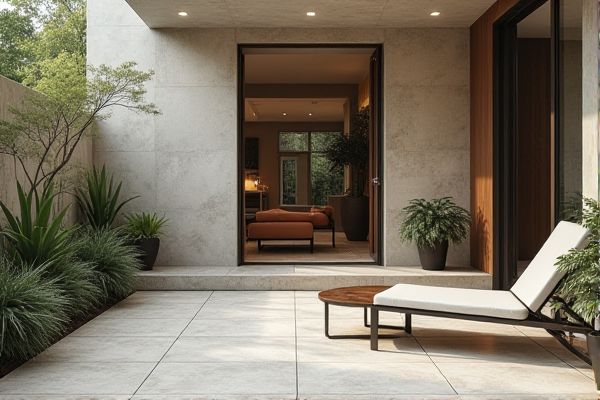
Light color tiles reflect more sunlight, keeping your terrace cooler and reducing heat absorption, ideal for warm climates. Explore the article to discover how choosing between light and dark tiles impacts your terrace's ambiance, maintenance, and comfort.
Table of Comparison
| Feature | Light Color Tiles | Dark Color Tiles |
|---|---|---|
| Heat Absorption | Reflect more sunlight, stay cooler | Absorb more heat, become warmer |
| Maintenance | Show dirt and stains less visibly | May show dust and water spots more |
| Visual Impact | Brighten space, enhance openness | Add depth, create cozy atmosphere |
| UV Fading | Less prone to visible fading over time | May fade more noticeably under sun exposure |
| Slip Resistance | Varies by finish, light colors can reflect glare | Often better at concealing wear and scratch marks |
| Energy Efficiency | Contribute to cooler terrace surfaces | Can raise local temperature, increasing cooling needs |
Introduction: Light Color Tiles vs Dark Tiles for Terraces
Light color tiles for terraces reflect sunlight, keeping surfaces cooler and reducing heat absorption, which enhances comfort during hot weather. Dark tiles absorb more heat, making your terrace warmer but offering a sleek, modern aesthetic that can complement certain design themes. Choosing between light and dark tiles depends on your climate preferences, terrace usage, and overall style goals.
Aesthetic Appeal: Setting the Mood with Tile Colors
Light color terrace tiles create an open and airy ambiance, enhancing natural sunlight and making outdoor spaces feel larger and more inviting. Dark tiles provide a rich, sophisticated look that adds depth and warmth, perfect for cozy or modern terrace designs. Choosing between light and dark tiles sets a distinct mood, influencing the terrace's overall aesthetic and atmosphere.
Heat Absorption: Temperature Differences Between Light and Dark Tiles
Dark tiles on terraces absorb more heat due to their lower albedo, resulting in surface temperatures that can be up to 30degF (17degC) higher than light-colored tiles under direct sunlight. Light-colored tiles reflect a significant portion of solar radiation, maintaining cooler surfaces and enhancing comfort during hot weather. This temperature difference impacts energy efficiency and outdoor usability by reducing heat buildup on terraces with light tiles.
Maintenance and Cleaning: Which Tiles Show Dirt Less?
Dark tiles on your terrace typically show dirt, dust, and water spots more visibly, requiring frequent cleaning to maintain their appearance. Light-colored tiles, while they may stain more easily, tend to mask dust and lighter debris better, reducing the need for constant upkeep. Choosing between the two depends on your tolerance for visible dirt and the amount of time you can dedicate to maintenance.
Durability and Fading: Color Longevity Under Sunlight
Light color tiles on your terrace reflect more sunlight, reducing heat absorption and minimizing the risk of fading over time, thus enhancing color longevity. Dark tiles absorb more UV rays and heat, which can accelerate fading and cause surface wear, potentially impacting their durability. Choosing lighter tiles helps maintain a vibrant appearance and long-lasting finish despite prolonged sun exposure.
Slip Resistance: Safety Considerations for Terrace Spaces
Light color tiles generally offer better visibility of water or spills, enhancing slip resistance on terrace spaces by allowing quicker detection and cleaning. Dark tiles may absorb more heat, causing surfaces to become slick when wet due to condensation or sweat, increasing slip hazards. Selecting textured finishes or anti-slip coatings improves safety across both light and dark tile options for terraces.
Space Perception: Enhancing Terrace Size with Tile Shades
Light color tiles on your terrace create an open and airy ambiance by reflecting more natural light, making the space appear larger and more inviting. Dark tiles absorb light, which can visually reduce the terrace size but add depth and a cozy, intimate feel. Choosing tile shades that complement your terrace's lighting conditions can significantly enhance space perception and overall outdoor comfort.
Cost Implications: Price Differences Between Light and Dark Tiles
Light color tiles for terraces generally come at a slightly higher price due to the demand for pigments and coatings that resist fading under sunlight, enhancing durability. Dark tiles may cost less upfront but can incur higher maintenance costs over time as they show dirt, stains, and wear more prominently, potentially requiring frequent cleaning or replacement. Your choice should weigh these cost implications alongside aesthetic preferences to optimize long-term value and appearance.
Best Uses: Ideal Applications for Light and Dark Terrace Tiles
Light color terrace tiles are ideal for outdoor spaces with ample sunlight, as they reflect heat and keep surfaces cooler, making them perfect for balconies, rooftop terraces, and poolside areas. Dark tiles absorb heat and are best suited for shaded or cooler terraces, outdoor kitchens, or cozy seating areas where warmth retention is beneficial. Your choice between light and dark tiles should consider the terrace's exposure to sunlight and desired ambiance to optimize comfort and aesthetic appeal.
Expert Tips: Choosing the Right Tile Color for Your Terrace
Light color tiles for terraces reflect sunlight, keeping surfaces cooler and reducing heat absorption, making them ideal for hot climates. Dark tiles absorb more heat, creating a warmer surface that can enhance outdoor ambiance in cooler seasons or climates. Experts recommend considering regional temperature, terrace usage, and maintenance preferences when selecting tile colors to balance aesthetics, comfort, and durability.
 homyna.com
homyna.com